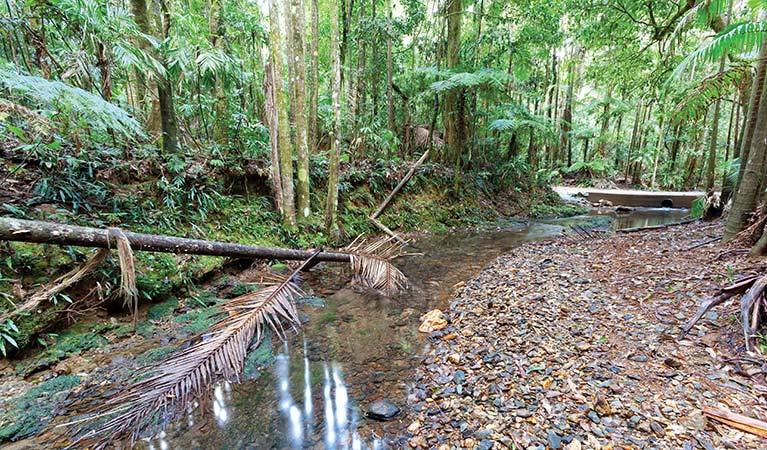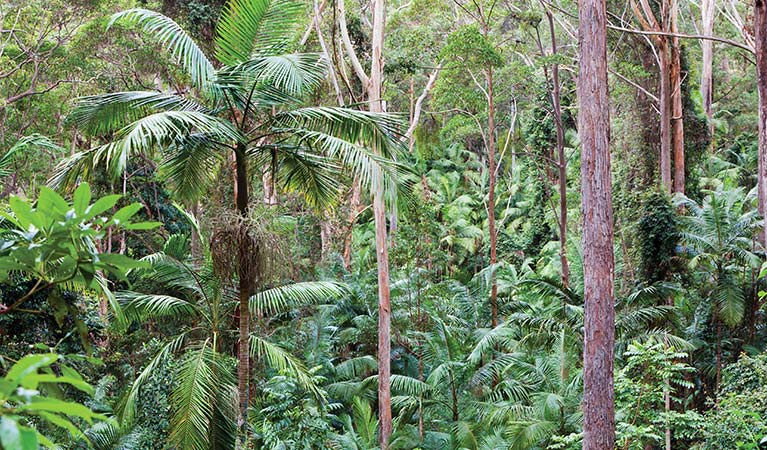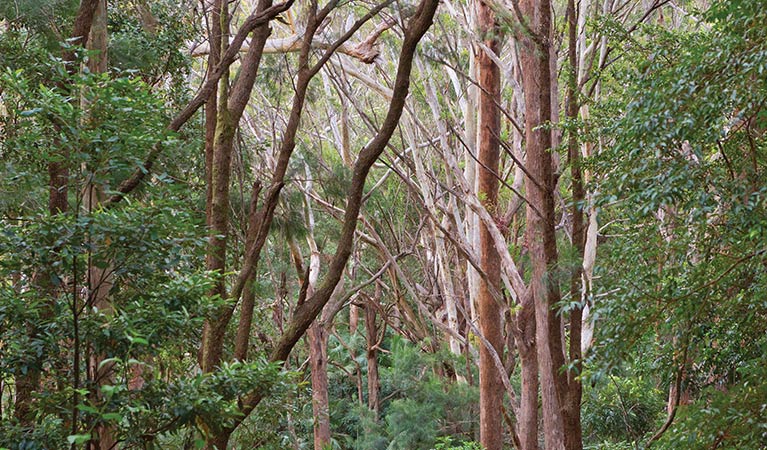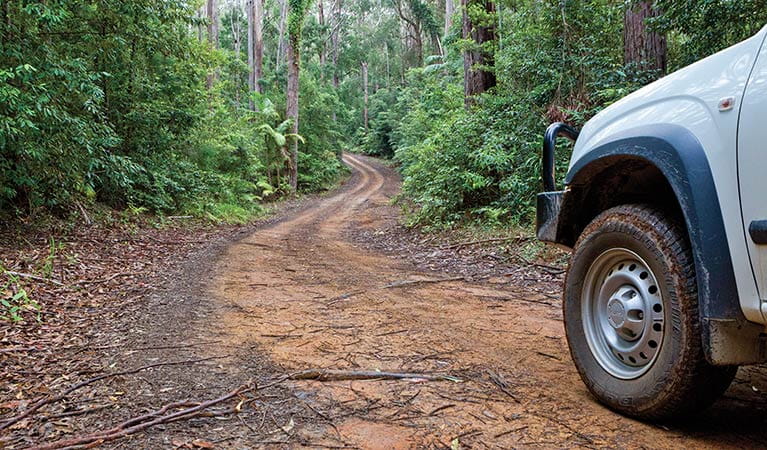Ulidarra National Park
Overview
Great birdwatching, 4WD driving, mountain biking and bushwalking are just some of the things waiting to be discovered in Ulidarra National Park near Coffs Harbour.
Read more about Ulidarra National Park
Ulidarra National Park truly is a hidden gem. Just west of Coffs Harbour on the NSW Mid North Coast, you’ll find majestic forests, vibrant birdlife, coastal views, 4WD trails and a network of mountain biking and bushwalking tracks just waiting to be explored.
Along with the adjoining Bruxner Park Flora Reserve, Ulidarra supports habitats for a large diversity of wildlife, including koalas, masked owls, wompoo fruit doves, dingoes and little bent-wing bats, making it a great destination for birdwatching.
Beautiful palm-fringed rainforests and majestic old eucalyptus trees also provide a stunning backdrop for a range of recreational activities. Ulidarra National Park has a network of management trails and walking tracks for bushwalking and mountain biking, fantastic 4WD trails to explore and an abundance of off-the-beaten-track places for a picnic.
Local alerts
For the latest updates on fires, closures and other alerts in this area, see https://www.nationalparks.nsw.gov.au/visit-a-park/parks/ulidarra-national-park/local-alerts
Contact
- in the North Coast region
Ulidarra National Park is always open but may have to close at times due to poor weather or fire danger.
-
-
Coffs Harbour office
02 6652 0900
Contact hours: Monday to Friday, 8.30am to 4.30pm. - 4/32 Edgar St, Coffs Harbour NSW 2450
-
Email: npws.coffscoast@environment.nsw.gov.au
-
Coffs Harbour office
Visitor info
All the practical information you need to know about Ulidarra National Park.
Map

Map legend

Maps and downloads
Nearby towns
Coffs Harbour (11 km)
Coffs Harbour is a coastal city on the North Coast, packed with things to do. It's surrounded by lush forests and national parks.
Woolgoolga (27 km)
Woolgoolga is a busy rural service town with a large Sikh population. It features a coastal setting surrounded by banana farms and forested hills.
Bellingen (45 km)
Bellingen is a laid-back, tree-lined town with a New Age vibe. It's set in a luxuriant valley beside the Bellinger River.
Learn more
Ulidarra National Park is a special place. Here are just some of the reasons why:
Precious plant life

Ulidarra National Park provides an important link between the hinterland and plateau habitats of the World Heritage-listed Dorrigo National Park, connecting the mountain ranges of Tuckers Nob in Bindarri National Park to the coastal habitats of Moonee Beach Nature Reserve and Coffs Coast Regional Park. The park conserves rare lowland rainforest, with species such as red carabeen, booyong and bangalow palms. You'll also find old growth sclerophyll forest with coastal blackbutt and turpentine trees, and small areas of wet sclerophyll forest dominated by brushbox.
- End Peak walking track End Peak walking track is a challenging walk that offers rewarding panoramic views of Coffs Harbour from Ulidarra National Park’s highest point. It’s great for birdwatching and for a picnic with a view.
Park of the people

From the early 1880s, Ulidarra National Park and the adjoining Bruxner Park Flora Reserve were used for logging. Throughout the park, you might come across tree stumps that bear the scars of board cuts, a style of tree felling that took place up until the early 1950s. Starting in the early 1930s, local community lobbying for the protection of these areas has seen the protection of Bruxner in 1933, the establishment of Bruxner Park Flora Reserve in 1958, and later the establishment of Ulidarra and nearby Bindarri National Park in 1999.
Mid North Coast menagerie

Along with the adjoining Bruxner Park Flora Reserve, Ulidarra provides important habitats for a diverse range of wildlife, including koalas, masked owls, dingoes and little bent-wing bats. Some 232 native vertebrate species make this beautiful place their home, including 40 different mammals, reptiles, frogs and fish. If you're lucky, you might spot threatened species such as Stephens banded snakes, yellow-bellied gliders and powerful owls. There are also 125 different bird species found in Ulidarra, making it a haven for birdwatching. Amongst the myriad of birds you'll find here, you might catch a glimpse of threatened species such as glossy black-cockatoos, brown tree-creepers, barred cuckoo-shrikes, black bitterns, barking owls, powerful owls, wompoo fruit-doves and rose-crowned fruit-doves.
- End Peak walking track End Peak walking track is a challenging walk that offers rewarding panoramic views of Coffs Harbour from Ulidarra National Park’s highest point. It’s great for birdwatching and for a picnic with a view.
- Ulidarra walking track Ulidarra walking track is a peaceful walk through the sub-tropical rainforest of Ulidarra National Park. 11km from Coffs Harbour and offering stunning views, it’s perfect for a day trip.
Land of Gumbaynggir

As you explore the remote bushland and admire the unspoilt beauty of Ulidarra National Park, you'll be walking on the traditional lands of the Gumbaynggirr People. The park is part of a larger 'men's area' and was once used for hunting and gathering of bush foods and medicines. The area continues to have special significance for Gumbaynggirr people as it connects them with their Dreamtime stories.
- Ulidarra walking track Ulidarra walking track is a peaceful walk through the sub-tropical rainforest of Ulidarra National Park. 11km from Coffs Harbour and offering stunning views, it’s perfect for a day trip.
Plants and animals protected in this park
Animals
-

Koala (Phascolarctos cinereus)
One of the most renowned Australian animals, the tree-dwelling marsupial koala can be found in gum tree forests and woodlands across eastern NSW, Victoria and Queensland, as well as in isolated regions in South Australia. With a vice-like grip, this perhaps most iconic but endangered Australian animal lives in tall eucalypts within a home range of several hectares.
-

Grey-headed flying-fox (Pteropus poliocephalus)
The grey-headed flying fox is Australia's largest native bat, with a wingspan up to 1m. This threatened species travels up and down south-eastern Australia and plays a vital role in pollinating plants and spreading seeds in our native forests.
-

Eastern bentwing-bat (Miniopterus schreibersii oceanensis)
Eastern bentwing-bats congregate in caves across the east and north-west coasts of Australia, in colonies of up to 150,000. These small Australian animals weigh around 13-17g and can reach speeds of up to 50km per hour. Eastern bentwing-bats use both sight and echolocation to catch small insects mid-air.
Education resources (1)
What we're doing
Ulidarra National Park has management strategies in place to protect and conserve the values of this park. View the detailed park and fire management documents.

